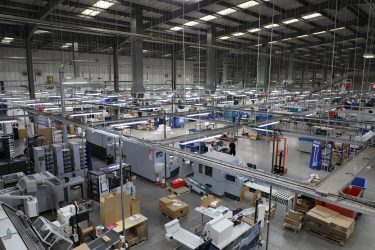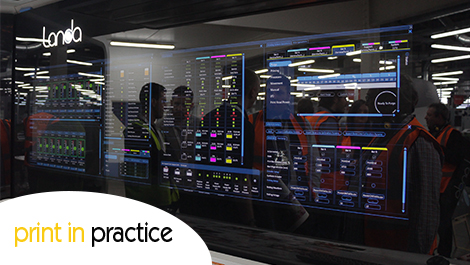The growth of South Yorkshire trade printer Route 1 Print has been little short of meteoric, and now it has the UK’s first Landa nanographic and MGI JetVarnish 3D Evo 75 embellishment presses.
Route 1 Print’s factory on a quiet industrial estate in Wath-upon-Dearne, just north of Rotherham, looks large but otherwise unremarkable from the outside. But inside, it’s a working showroom for state-of-the-art presses, both analogue and digital, finishing equipment and a custom workflow that can handle thousands of jobs a day. A tour of the factory floor is an exercise in classical perspective, with lines of overhead trunking and data and power cable drops converging almost at infinity.
How did they get here? Adam Carnell and James Kinsella launched Instantprint in 2009 as an online small format digital print business before merging in 2012 with screen printer Bluetree in 2012, and launching Route 1 Print, initially an eBay store. This attracted print resellers as customers, filling what Mr Carnell saw as ‘a shortage in the market’. 2012 also saw the group’s first investment in litho print; wide format print was added in 2014.
The fist £1 million turnover month for Instantprint was achieved in 2016, and the year after for Route 1. A Fujifilm JetPress B2 inkjet was installed in 2017 and is used exclusively for printing business cards in a ‘cell’ arrangement that surrounds the press with the relevant finishing and packing equipment; the spot-UV and foiling capabilities of the MGI JetVarnish 3D Evo 75 installed at the start of 2020 are being tested as an upsell option for business cards, among other items. The cell approach is also applied to book production (including both booklets and perfect bound) and for flat and folded products such as leaflets and flyers.
A Screen TruepressJet 520 roll-fed inkjet was added in 2018 for booklet production, and last year saw the addition of a second unit on the site which will bring total space to over 140,000sqft, with plans to link the two buildings already underway. The Landa S10P B1 perfecting nanographic press was installed some months ago but shown to the public last month.
Route 1 Print now has over 400 staff, pays all of them a living wage or more and head of Route 1 Mark Young told visitors to the open days ‘our factory is your factory’. Its approach to helping its customers grow their businesses includes offering an API to integrate online ordering directly from customer websites, including those based on WordPress, into Route 1’s production systems, a development of the Bluetree Connect concept introduced in 2013. Mr Kinsella said that he sees this integration with customers as ‘a big part of the business going forward,’ and the service is now being pitched as an ‘easy-to-use web platform’, supported by industry experts whose advice is intended to help clients grow their business.
Adding to the repertoire

Inside Route 1’s premises in Yorkshire
Additions to the product offering in addition to the expanded wide-format services include the option to have unfinished sheets delivered, for customers to manage their own
finishing. Value-added services such as item counting and branded labelling are in development. A straw poll of desired products on the open day that Digital Printer attended included personalised brochures, foiling, embossing, split deliveries and bespoke sizes. Many of these are already in the pipeline, and the bespoke sizes – within limits – are being investigated too, though within the constraints of what Mr Carnell called ‘standardised processes’, which are key to Route 1’s ability to handle thousands of orders a day.
To do this, the company wrote its own production management systems to keep everything moving in as automated a way as possible. ‘From printing, the first touch is packing shrink-wrapped items,’ says Lewis Rogal. The data flows to support this offer real-time tracking, plus API-based integration with courier services such as TNT and Royal Mail. The digital print fleet also includes Xerox iGen 5 for SRA3 output and an HP Indigo 10000 for B2, used extensively for flyers and leaflets; in November 2019 it recorded 4.8 million clicks, though 4 million a month is more typical. Indigo is used for higher coverage jobs, while lower coverage work is routed to the Screen inkjet. Perfect binding is done on Horizon BQ 470 and 480 binders and is one of the biggest growth areas at the moment. Booklet-making is done with Horizon Stitchliner Mk IIIs and a 5500, typically handling between 120 and 150 booklet jobs per shift with finishing make-ready achieved in around three minutes. Polar guillotines are also set up electronically and can be ready for a new job in 30 seconds.
Folding duties are performed by three Stahl machines which can process batched-up work at up to 90,000 items an hour in total. Work on heavier stocks from 200 to 450gsm is handled on MB Bäuerle units at up to 30,000 items per hour; ‘digital’ folding solutions were rejected as being too slow. Die cutting is done on a venerable Heidelberg cylinder. Dashboard displays around the production floor show workload and progress.
‘We used to focus on getting work to process,’ commented Mr Rogal, ‘now it’s about getting it away from it’. To further this, roller feed systems are used to transport finished work to wrap and despatch stations. Barcodes are widely used to route jobs. In the November 2019 peak some 8000 jobs a day were being processed. ‘We don’t stack pallets, work goes straight into despatch,’ he adds.
On the wide-format side an HP Scitex FB500 hybrid printer churns out signage, PoP and exhibition work a rate that can cover the entire factory floor in a shift. It’s paired with Kongsberg cutting table and Route 1 produced 450 roller banners a day, a figure that it says is the highest in the UK. Mr Carnell told Digital Printer that Route 1 will be moving into textile printing, initially via offering soft signage products. ‘We’re learning the materials and the technology at the moment,’ he said. Given what the Bluetree Group has achieved in little over a decade, you might think that they will have to slow down now. They’re not showing any signs of it.





